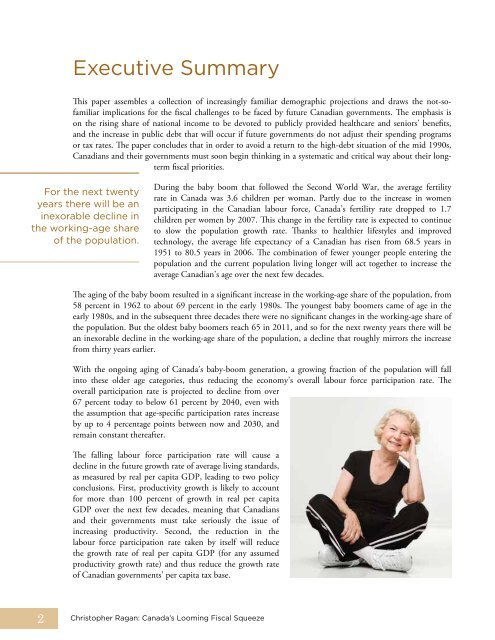Christopher Ragan, "Canada's Looming Fiscal Squeeze," November
Christopher Ragan, "Canada's Looming Fiscal Squeeze," November
Christopher Ragan, "Canada's Looming Fiscal Squeeze," November
You also want an ePaper? Increase the reach of your titles
YUMPU automatically turns print PDFs into web optimized ePapers that Google loves.
2<br />
Executive Summary<br />
This paper assembles a collection of increasingly familiar demographic projections and draws the not-sofamiliar<br />
implications for the fiscal challenges to be faced by future Canadian governments. The emphasis is<br />
on the rising share of national income to be devoted to publicly provided healthcare and seniors’ benefits,<br />
and the increase in public debt that will occur if future governments do not adjust their spending programs<br />
or tax rates. The paper concludes that in order to avoid a return to the high-debt situation of the mid 1990s,<br />
Canadians and their governments must soon begin thinking in a systematic and critical way about their longterm<br />
fiscal priorities.<br />
For the next twenty<br />
years there will be an<br />
inexorable decline in<br />
the working-age share<br />
of the population.<br />
During the baby boom that followed the Second World War, the average fertility<br />
rate in Canada was 3.6 children per woman. Partly due to the increase in women<br />
participating in the Canadian labour force, Canada’s fertility rate dropped to 1.7<br />
children per women by 2007. This change in the fertility rate is expected to continue<br />
to slow the population growth rate. Thanks to healthier lifestyles and improved<br />
technology, the average life expectancy of a Canadian has risen from 68.5 years in<br />
1951 to 80.5 years in 2006. The combination of fewer younger people entering the<br />
population and the current population living longer will act together to increase the<br />
average Canadian’s age over the next few decades.<br />
The aging of the baby boom resulted in a significant increase in the working-age share of the population, from<br />
58 percent in 1962 to about 69 percent in the early 1980s. The youngest baby boomers came of age in the<br />
early 1980s, and in the subsequent three decades there were no significant changes in the working-age share of<br />
the population. but the oldest baby boomers reach 65 in 2011, and so for the next twenty years there will be<br />
an inexorable decline in the working-age share of the population, a decline that roughly mirrors the increase<br />
from thirty years earlier.<br />
With the ongoing aging of Canada’s baby-boom generation, a growing fraction of the population will fall<br />
into these older age categories, thus reducing the economy’s overall labour force participation rate. The<br />
overall participation rate is projected to decline from over<br />
67 percent today to below 61 percent by 2040, even with<br />
the assumption that age-specific participation rates increase<br />
by up to 4 percentage points between now and 2030, and<br />
remain constant thereafter.<br />
The falling labour force participation rate will cause a<br />
decline in the future growth rate of average living standards,<br />
as measured by real per capita GDP, leading to two policy<br />
conclusions. First, productivity growth is likely to account<br />
for more than 100 percent of growth in real per capita<br />
GDP over the next few decades, meaning that Canadians<br />
and their governments must take seriously the issue of<br />
increasing productivity. Second, the reduction in the<br />
labour force participation rate taken by itself will reduce<br />
the growth rate of real per capita GDP (for any assumed<br />
productivity growth rate) and thus reduce the growth rate<br />
of Canadian governments’ per capita tax base.<br />
<strong>Christopher</strong> <strong>Ragan</strong>: Canada’s <strong>Looming</strong> <strong>Fiscal</strong> <strong>Squeeze</strong>





